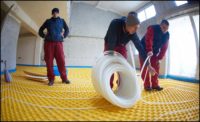Project Delivery Method: Integrated project delivery (IPD)
Owner Team: The building owner, owner representative (consultant), and facility manager (out-source staff)
Project Delivery Team: IPD project manager; job superintendent; mechanical-electrical coordinator; and architect, HVAC, plumbing, electrical, structural, fire protection, and security consultants
HVAC Project Team: HVAC contractor project manager; ATC technician (out-source staff); building automation system (BAS) technician (in-house staff); O&M technician (out-source staff); third-party commissioning consultant (CxC); and testing, adjusting, and balancing (TAB) technician
Application 2019 ASHRAE Handbook: Commercial and public buildings, Chapter 3
Systems and Equipment, 2020 ASHRAE Handbook: Air-handling and distribution, Chapter 4; In-Room Terminal Systems, Chapter 5; and Radiant Heating and Cooling, Chapter 6
Project Type: Renovation
References: Refer to the codes and standards section in the back of each ASHRAE Handbook for additional reference
Other References: ASHRAE Indoor-Air Quality Guide: Best Practice for Design, Construction, & Commissioning; ASHRAE Practical Guide to Seismic Restraints; ASHRAE Standard Practice for Inspection & Maintenance of Commercial Building HVAC Systems; ASHRAE Standard 55 (Thermal Environmental Conditions for Human Occupancy); ASHRAE Standard 62.1 (IAQ); and ASHRAE Standard 202 (Commissioning Process for Buildings and Systems)
DESIGN INTENT DOCUMENT (DID)
- The HVAC system selection and design intent is based on the processed outlined in ASHRAE Handbook 2020, Chapter 1, HVAC System Analysis and Selection, and includes the following:
- Owner’s building program goals and additional goals
- System constraints and constructability constraints
- Finalized system selection shall be decentralized HVAC systems with terminal units
- Automatic controls shall include temperature controls, equipment furnished controls, BACnet interface, internet interface, existing BAS interface, and out-source O&M firm’s existing computerized maintenance management software (CMMS) system interface
- Program and project goals:
- Budget goals: first cost and operating cost
- Timeline goals: occupancy move-in date; one year from “authorization-to-proceed”
- Management goals: property management and out-source mechanical and electrical services
- Available utilities: natural gas, electricity, and BAS system
- Existing conditions:
- Central air systems supply air and/or return air cfm, general exhaust, and toilet exhaust
- Heating system: hot water heating
- Air conditioning system: air-cooled chiller
- Sheet metal: low velocity and medium galvanized sheet metal with volume dampers and fire dampers
- Pumps: existing end suction primary-secondary pumping with a variable frequency drive (VFD)
DESIGN CRITERIA DOCUMENT
- The HVAC design criteria shall be in sync with the project delivery method and the owner’s project requirements
- The design criteria shall be based on ASHRAE 90.1 and state energy code compliance for outdoor air temperature compliance
- Reuse existing utilities and central heating and chilled water systems
- The new automatic controls shall be interfaced with the existing BAS system
- The existing central plants shall provide heating in the winter to maintain 68°F and 76° in the air conditioning season via a single duct, single zone, providing ventilation air and maintaining a positive building pressure of 0.05 inch gage
- Existing central air systems shall have new MERV-7 prefilters and a MERV-14 final filter
- Existing VAV and fan-powered air terminals shall be replaced with passive chilled beams and radiant heat ceiling panels
- Conceptual/schematic phase general notes: HVAC design engineer shall provide system flow diagrams with these three documents (OPR, DID, & BOD) along with ATC sequences of operation
Click here to see this month’s quiz.
Click here to see the answers to this month’s quiz.





